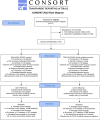Impact and process evaluation of a primary-school Food Education and Sustainability Training (FEAST) program in 10-12-year-old children in Australia: pragmatic cluster non-randomized controlled trial
- PMID: 38429629
- PMCID: PMC10905805
- DOI: 10.1186/s12889-024-18079-8
Impact and process evaluation of a primary-school Food Education and Sustainability Training (FEAST) program in 10-12-year-old children in Australia: pragmatic cluster non-randomized controlled trial
Abstract
Background: Environmentally sustainable food initiatives accompanying nutrition education, such as the Food Education and Sustainability Training (FEAST) program, have gained traction in school settings. The aim of this trial was to conduct an impact and process evaluation of FEAST, to evaluate its effect on children's fruit and vegetable (F&V) intakes, and secondary outcomes: F&V variety consumed, nutrition knowledge, food preparation/cooking skills, self-efficacy and behaviours, food waste knowledge and behaviours, and food production knowledge.
Methods: FEAST was a 10-week curriculum-aligned program, designed to educate children about healthy eating, food waste, and sustainability, while teaching cooking skills. It was implemented by classroom teachers, face-to-face and online, during COVID-19 school closures, in Australia in 2021. A custom designed survey was used to collect baseline and post-intervention data from students. Generalised linear mixed models (GLMM) estimated group differences in pre-post changes for primary and secondary outcomes. Surveys were also administered to students and teachers to evaluate intervention implementation.
Results: Twenty schools participated and self-selected to be either intervention schools (n = 10) or wait-list control (WLC) schools (n = 10). A total of 977, 5th and 6th grade children participated in the trial with a mean age of 11.1 years (SD ± 0.7). The FEAST intervention, compared to WLC, did not result in significant increases in primary outcomes nor secondary outcomes. The process evaluation revealed FEAST was well-received by students and teachers, but COVID-19 school closures hindered implementation fidelity with a less intense program delivered under the constraints of pandemic lockdowns.
Conclusions: This is the first cluster non-randomized controlled trial designed to independently evaluate FEAST in the primary-school setting. No evidence was found for improved F&V intakes in children, nor secondary outcomes. However, the positive process evaluation results suggest that further trials of the program are warranted. If implemented as originally designed (pre-pandemic), with increased duration and complemented by supporting school policies, such programs have the potential to improve children's daily F&V intakes, cooking skills and food waste behaviours. This would support the Australian curriculum and contribute to: health promotion within schools and sustainable schools initiatives, the national agenda to reduce food waste and sustainable development goals. AUSTRALIAN AND NEW ZEALAND CLINICAL TRIALS REGISTRY: [ACTRN12620001347954]- Registered prospectively on 14/12/2020.
Keywords: Children; Cluster non-randomized controlled trial; Education; Food; Fruit; Impact evaluation; Nutrition; Process evaluation; School; Sustainability; Vegetable.
© 2024. The Author(s).
Conflict of interest statement
The authors declare no competing interests.
Figures
Similar articles
-
Evaluating OzHarvest's primary-school Food Education and Sustainability Training (FEAST) program in 10-12-year-old children in Australia: protocol for a pragmatic cluster non-randomized controlled trial.BMC Public Health. 2021 May 22;21(1):967. doi: 10.1186/s12889-021-10302-0. BMC Public Health. 2021. PMID: 34022839 Free PMC article. Clinical Trial.
-
Evaluation of the PhunkyFoods intervention on food literacy and cooking skills of children aged 7-9 years: a cluster randomised controlled trial in Yorkshire Primary Schools UK.Trials. 2022 Aug 1;23(1):618. doi: 10.1186/s13063-022-06558-5. Trials. 2022. PMID: 35915460 Free PMC article. Clinical Trial.
-
Integrating nutrition into the mathematics curriculum in Australian primary schools: protocol for a randomised controlled trial.Nutr J. 2020 Nov 26;19(1):128. doi: 10.1186/s12937-020-00640-x. Nutr J. 2020. PMID: 33243231 Free PMC article.
-
Sustainability and public health nutrition at school: assessing the integration of healthy and environmentally sustainable food initiatives in Vancouver schools.Public Health Nutr. 2015 Sep;18(13):2379-91. doi: 10.1017/S1368980015000531. Epub 2015 Mar 16. Public Health Nutr. 2015. PMID: 25771940 Free PMC article. Review.
-
School lunchboxes as an opportunity for health and environmental considerations: a scoping review.Health Promot Int. 2023 Feb 1;38(1):daac201. doi: 10.1093/heapro/daac201. Health Promot Int. 2023. PMID: 36715703 Free PMC article.
Cited by
-
School food and nutrition environments in Australian primary schools: A scoping review.PLoS One. 2025 Jul 1;20(7):e0327310. doi: 10.1371/journal.pone.0327310. eCollection 2025. PLoS One. 2025. PMID: 40591617 Free PMC article.
-
Evaluation of the Influence of Intervention Tools Used in Nutrition Education Programs: A Mixed Approach.Nutrients. 2025 Jul 28;17(15):2460. doi: 10.3390/nu17152460. Nutrients. 2025. PMID: 40806045 Free PMC article. Review.
-
Nutritional Intervention Programs for Sustainability: A Scoping Review on Full Food Utilization and the Clean Leftovers Reuse.Nutrients. 2025 May 28;17(11):1829. doi: 10.3390/nu17111829. Nutrients. 2025. PMID: 40507098 Free PMC article.
-
Process evaluation of Project Daire: a food environment intervention that impacted food knowledge, wellbeing and dietary habits of primary school children.BMC Public Health. 2025 Feb 6;25(1):486. doi: 10.1186/s12889-025-21628-4. BMC Public Health. 2025. PMID: 39910503 Free PMC article. Clinical Trial.
References
-
- Rosi A, Paolella G, Biasini B, Scazzina F. Dietary habits of adolescents living in North America, Europe or Oceania: a review on fruit, vegetable and legume consumption, sodium intake, and adherence to the Mediterranean Diet. Nutr Metab Cardiovasc Dis. 2019;29(6):544–60. - PubMed
-
- Children eating more. fruit, but fruit and vegetable intake still too low [https://www.cdc.gov/media/releases/2014/p0805-fruits-vegetables.html].
-
- Dietary behaviour.: Key statistics and data about child and adult consumption of fruit, vegetables, sugar sweetened, and diet drinks [Internet] [https://www.abs.gov.au/statistics/health/health-conditions-and-risks/die...].
Publication types
MeSH terms
Grants and funding
LinkOut - more resources
Full Text Sources
Medical


